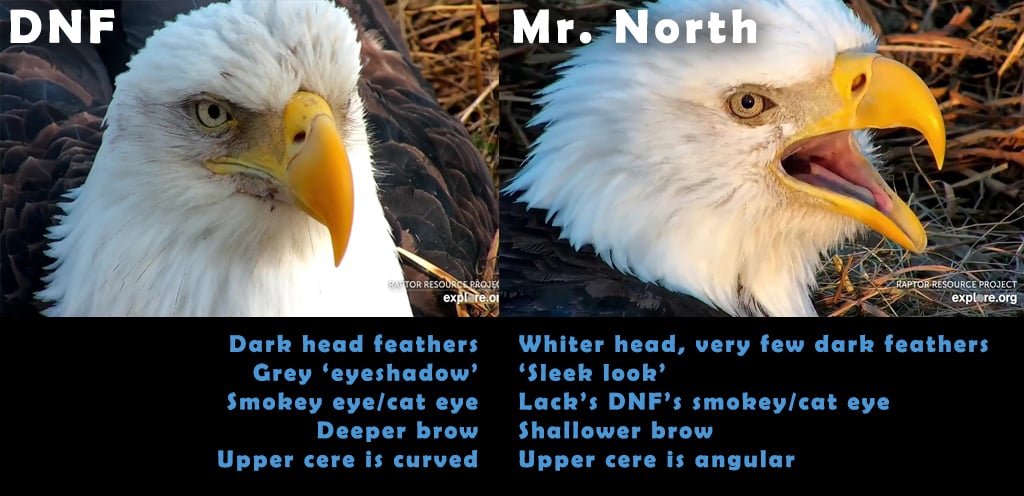About the Eagles
The Decorah North eagles are nesting on private property north of Decorah, Iowa. Their nest is located in a white oak tree in a scrap of forest bordering a valley. A stream is located across a field where cattle are pastured. In general, the eagles begin courtship in October, productive mating in late January or early February, and egg-laying in mid to late February. Hatching usually begins in late March to early April, and the eaglets fledge in mid-to-late June. While young usually disperse between August and October, the adults remain on territory year round.
The eagles eat live and dead fish, squirrels, other birds, rabbit, muskrat, deer, possum and anything else they can catch or find. To learn more about bald eagles in general, please follow this link to the Cornell Lab of Ornithology website.
Adults

Decorah North Bald Eagles: DNF and Mr. North
The male is known as Mr. North. The female is the Decorah North Female, or DNF, who replaced Mrs. North in the summer of 2018. We don’t know exactly how or when it happened. You can read more about it here: https://www.raptorresource.org/2019/01/20/north-nest-announcement/
Nests
The first nest at the North site was built in a pine tree. The branches collapsed after the second nesting season and the eagles moved to a dead elm tree. They nested there for just one year before moving to their current location in late 2013. In August of 2018, their nest collapsed and slid or fell out of the nest tree during an extremely heavy storm. None of the tree branches were broken or damaged, so we decided to build a starter nest in the same spot. 2020 will mark their seventh season and fourth nest on this territory.
- 2018: A female eagle (DNF, or Decorah North Female) replaces Mrs. North over the summer. The nest falls out of the tree following a storm in late August. Kike Arnal and Amy Ries build a starter nest in mid-September. Mr. North and DNF adopt it in October.
- 2015: RRP adds cameras to the North Nest in September.
- 2013: The tree falls. The eagles begin a new nest in a white oak tree.
- 2011: The branches holding the nest collapse. The eagles build a new nest in a dead elm tree.
- 2009: A pair of eagles establishes the Decorah North territory, building a nest in a white pine tree.
The North nest is 56 feet off the ground.
- In 2021, the nest was 8.25 feet at its longest point and 6.25 feet at its widest point. Measured outermost stick to outermost stick, the nest measured 12 feet across. We can’t really get a height on it, since we can’t get anywhere near the bottom and the nest slopes downward from the top. Our best guess is six feet high at its tallest measure.
- In 2019, the nest was seven feet long at its longest point, four feet wide at its widest point, was about 3.5 feet high, and had a perimeter of roughly 18 feet.
 The Raptor Resource Project
The Raptor Resource Project The Raptor Resource Project
The Raptor Resource Project